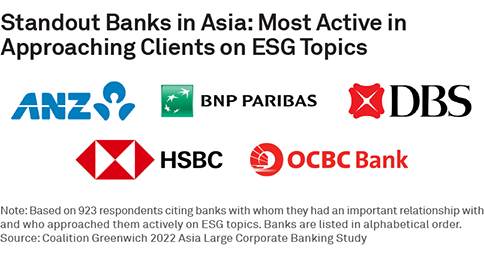
Banks of all sizes have an opportunity to strengthen client relationships in Asia by helping companies adopt and implement ESG driven practices. Although Asian corporates have been slower than their counterparts in Europe to adopt environmental, social and governance standards, companies across the region are now making fast progress with ~70% of respondents talking about having a clear ESG target or goal (~80% for Europe).
These companies are motivated to act on ESG due to increased scrutiny by shareholders, consumers and government regulators. Over the last few years for many companies, the first step has been to tap capital markets through green bonds and similar instruments. As companies rushed to lock in low-cost funding, the boom in green financing helped some banks meet their five-year ESG related financing goals, in two years or less.
Despite this progress, most Asian companies are still learning what ESG means to their organizations and which ESG factors are material to their businesses. This is an opportunity for banks that have the capability, regardless of size, to help clients navigate their ESG journey. For example, launch and educate clients on ‘green’ products, share best practices etc.
Banks should be working to build and strengthen client relationships by helping large Asian companies create the frameworks needed to measure, monitor and report ESG not only in traditional treasury functions like financing, trade finance and supply chain management, but throughout their entire business. Actively helping clients set and meet their ESG goals will help cement relationships and is a unique opportunity to compete on a more level playing field.

From September 2021 to January 2022, Coalition Greenwich conducted 923 interviews in large corporate banking and 1,131 interviews in large corporate cash management at companies in China, Hong Kong, India, Indonesia, Laos, Malaysia, Myanmar, the Philippines, Singapore, South Korea, Taiwan, Thailand, and Vietnam. Subjects covered included product demand, quality of coverage, and capabilities in specific product areas.

